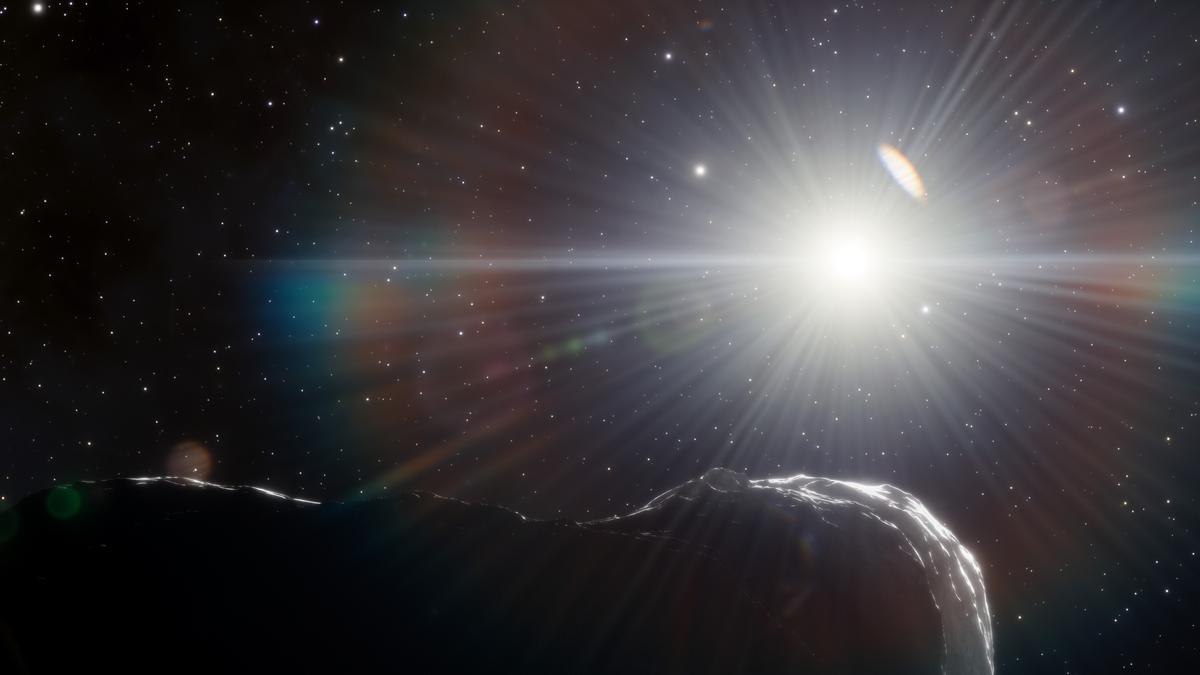Picture a space rock smashing into the moon. It sends splinters of moon rock flying into the dark void of space. What would that spectacle look like?
Scientists used the ATLAS telescope in Rio Hurtado, Chile, to discover asteroid 2024 YR4 in December 2024 as a new entrant in the asteroid databases — and it made a splash. Since its discovery, it has kept planetary defense scientists on their toes because of the possibility that it could collide with the earth someday.
Alarm on, alarm off
YR4 is a near-earth asteroid, an object orbiting the sun whose closest approach to the star is within 1.3-times the earth-sun distance. Such asteroids are classified as potentially hazardous objects if their orbits cross the earth’s and they are more than 140 m wide.
Astronomers first estimated asteroid YR4’s size using wide-field ground-based telescopes operating in the visible range. Infrared observations from the James Webb Space Telescope have since revealed a clearer picture of the asteroid’s size. YR4 is now estimated to be 65 m wide, about the size of a 10-storey building. To compare, the space rock that wiped out the dinosaurs 66 million years ago was 10 km wide.
Even though YR4 didn’t meet the 140-m threshold, its non-small size plus its trajectory were enough for NASA to sound the highest-ever (in its history) asteroid impact alert in mid-February. The agency had announced then that YR4 had a 3.1% chance of hitting the earth in 2032. In a subsequent update, with more data and closer analysis, NASA rolled that update back saying its chance of hitting the earth was actually negligible and that it might strike another body instead.
Probability of impact
On April 2, NASA announced that there was a 3.8% chance YR4 could collide with the moon on December 22, 2032, about seven and half years away. But there’s still a 96.2% chance it will miss.
The observatories built by astronomers are constantly on the lookout for new asteroids in the sky and also keep an eye on known potentially hazardous ones. Scientists use observational data they collect to build computer models to figure out the orbits of these objects. (When they enter the solar system, the sun’s gravity puts them in an orbit around itself.) Researchers then have these models check if a future orbit intersects with that of the earth.
“Asteroids and other near-earth objects are almost all found by automated searches now,” Jayant Murthy, honorary professor at the Indian Institute of Astrophysics, Bengaluru, said. “That is, they take successive pictures of the sky and use an algorithm to search for anything that moves.”
“If an object is newly discovered, the orbit is uncertain. In other words, several similar orbits can fit the observations. The group of possible orbits is used to calculate a probability of impact,” Carrie Nugent, science communicator and associate professor at Olin College, Massachusetts, said. She is the author of the 2017 book ‘Asteroid Hunters’.
Both Nugent and Murthy have asteroids named after them.
Seeing it coming
“The problem is that many of these objects are faint and don’t have a history of observations, so they try to get the orbit from very few points. There is therefore some uncertainty about the path of the orbit and that is … reflected in the numbers,” Murthy said.
As scientists acquire more data, they refine estimates of the asteroid’s size and path and update their models. This leads to more accurate predictions of where an asteroid will be in future.
The NASA Sentry website lists the latest impact probability of all asteroids of note. It uses the Torino scale to assess each rock’s hazard to the earth. A Torino rating of 0 indicates no threat and 10 indicates a global disaster. YR4 had a Torino rating of 3 before astronomers found it to be mostly harmless.
Even should YR4 slam into the moon, the moon’s orbit won’t change — but it will gouge out a 500- to 2,000-metre-wide impact crater. The impact area will shudder with a terrifying explosion 340-times more powerful than the Hiroshima bomb.
Spacecraft in orbit around the moon, such as India’s Chandrayaan-2 orbiter, will be able to see it coming.
A preventable disaster
Astronomers are however divided on whether the impact will be visible from the earth. Some scientists say it won’t be visible to the unaided eye due to the moon’s brightness. Others differ: for example, Gareth Collins, a professor of planetary science at Imperial College London, told New Scientist in February that “the impact flash of vaporised rock would be visible from earth, even in the daytime”.
“It would be very exciting to get to see it!” Nugent said.
“You will just get a bright flash on the moon. If it is on the near side, there will be [many] telescopes observing it because it will tell you about the lunar regolith and its composition,” Murthy said.
YR4 will pass by the earth again in 2028. Scientists will be able to acquire more data about it after a four-year gap, refine their models, and develop a better picture of whether the asteroid might strike the moon.
Finally, even though YR4 went from ‘threat’ to ‘no threat’ for the earth, the planet is still bombarded by rocks from space, like the 2013 Chelyabinsk meteor. “The problem with larger asteroids is that the earth is quite fragile and an asteroid would dump lots of dust in the atmosphere, which would drastically affect the climate for years, or decades, before life recovers,” Murthy said.
“We have had potentially catastrophic collisions in the last century and we know that there is always the big one coming.”
Yet there’s also hope. As Nugent said: “Asteroids are the only preventable natural disaster.”
Unnati Ashar is a freelance science journalist with a master’s degree in space physics.
Published – May 12, 2025 05:30 am IST
